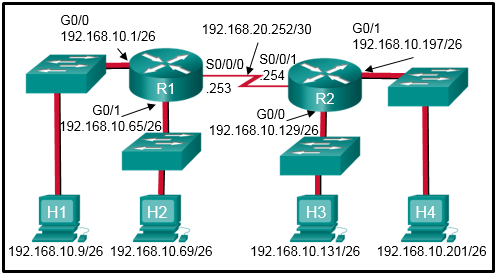
How to find: Press “Ctrl + F” in the browser and fill in whatever wording is in the question to find that question/answer. If the question is not here, find it in Questions Bank.
NOTE: If you have the new question on this test, please comment Question and Multiple-Choice list in form below this article. We will update answers for you in the shortest time. Thank you! We truly value your contribution to the website.
1. The IT department is reporting that a company web server is receiving an abnormally high number of web page requests from different locations simultaneously. Which type of security attack is occurring?
2. What causes a buffer overflow?
3. Which objective of secure communications is achieved by encrypting data?
Explanation: When data is encrypted, it is scrambled to keep the data private and confidential so that only authorized recipients can read the message. A hash function is another way of providing confidentiality.
4. What type of malware has the primary objective of spreading across the network?
5. What commonly motivates cybercriminals to attack networks as compared to hactivists or state-sponsored hackers?
Explanation: Cybercriminals are commonly motivated by money. Hackers are known to hack for status. Cyberterrorists are motivated to commit cybercrimes for religious or political reasons.
6. Which type of hacker is motivated to protest against political and social issues?
Explanation: Hackers are categorized by motivating factors. Hacktivists are motivated by protesting political and social issues.
7. What is a ping sweep?
Explanation: A ping sweep is a tool that is used during a reconnaissance attack. Other tools that might be used during this type of attack include a ping sweep, port scan, or Internet information query. A reconnaissance attack is used to gather information about a particular network, usually in preparation for another type of network attack.
8. In what type of attack is a cybercriminal attempting to prevent legitimate users from accessing network services?
Explanation: In a DoS or denial-of-service attack, the goal of the attacker is to prevent legitimate users from accessing network services.
9. Which requirement of secure communications is ensured by the implementation of MD5 or SHA hash generating algorithms?
Explanation: Integrity is ensured by implementing either MD5 or SHA hash generating algorithms. Many modern networks ensure authentication with protocols, such as HMAC. Data confidentiality is ensured through symmetric encryption algorithms, including DES, 3DES, and AES. Data confidentiality can also be ensured using asymmetric algorithms, including RSA and PKI.
10. If an asymmetric algorithm uses a public key to encrypt data, what is used to decrypt it?
Explanation: When an asymmetric algorithm is used, public and private keys are used for the encryption. Either key can be used for encryption, but the complementary matched key must be used for the decryption. For example if the public key is used for encryption, then the private key must be used for the decryption.
11. Refer to the exhibit. Which two ACLs would permit only the two LAN networks attached to R1 to access the network that connects to R2 G0/1 interface? (Choose two.)

Explanation: The permit 192.168.10.0 0.0.0.127 command ignores bit positions 1 through 7, which means that addresses 192.168.10.0 through 192.168.10.127 are allowed through. The two ACEs of permit 192.168.10.0 0.0.0.63 and permit 192.168.10.64 0.0.0.63 allow the same address range through the router.
12. Which two packet filters could a network administrator use on an IPv4 extended ACL? (Choose two.)
Explanation: Extended access lists commonly filter on source and destination IPv4 addresses and TCP or UDP port numbers. Additional filtering can be provided for protocol types.
13. What type of ACL offers greater flexibility and control over network access?
Explanation: The two types of ACLs are standard and extended. Both types can be named or numbered, but extended ACLs offer greater flexibility.
14. What is the quickest way to remove a single ACE from a named ACL?
Explanation: Named ACL ACEs can be removed using the no command followed by the sequence number.
15. Refer to the exhibit. A network administrator is configuring a standard IPv4 ACL. What is the effect after the command no access-list 10 is entered?
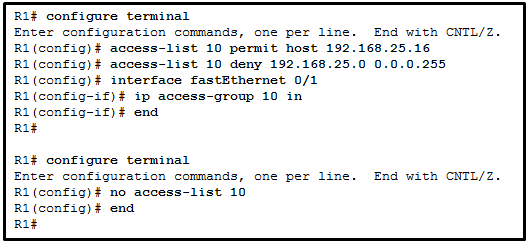
Explanation: The R1(config)# no access-list command removes the ACL from the running-config immediately. However, to disable an ACL on an interface, the command R1(config-if)# no ip access-group should be entered.
16. Refer to the exhibit. A network administrator has configured ACL 9 as shown. Users on the 172.31.1.0 /24 network cannot forward traffic through router CiscoVille. What is the most likely cause of the traffic failure?
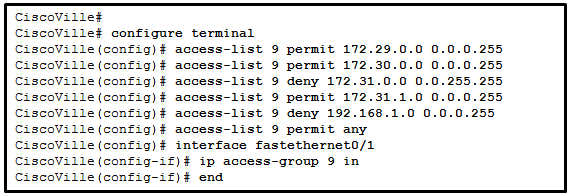
Explanation: When verifying an ACL, the statements are always listed in a sequential order. Even though there is an explicit permit for the traffic that is sourced from network 172.31.1.0 /24, it is being denied due to the previously implemented ACE of CiscoVille(config)# access-list 9 deny 172.31.0.0 0.0.255.255. The sequence of the ACEs must be modified to permit the specific traffic that is sourced from network 172.31.1.0 /24 and then to deny 172.31.0.0 /16.
17. A network administrator needs to configure a standard ACL so that only the workstation of the administrator with the IP address 192.168.15.23 can access the virtual terminal of the main router. Which two configuration commands can achieve the task? (Choose two.)
Explanation: To permit or deny one specific IP address, either the wildcard mask 0.0.0.0 (used after the IP address) or the wildcard mask keyword host (used before the IP address) can be used.
18. Refer to the exhibit. Which command would be used in a standard ACL to allow only devices on the network attached to R2 G0/0 interface to access the networks attached to R1?
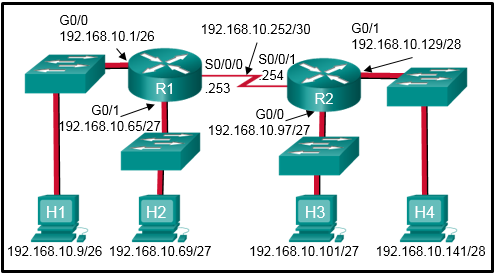
Explanation: Standard access lists only filter on the source IP address. In the design, the packets would be coming from the 192.168.10.96/27 network (the R2 G0/0 network). The correct ACL is access-list 1 permit 192.168.10.96 0.0.0.31.
19. A network administrator is writing a standard ACL that will deny any traffic from the 172.16.0.0/16 network, but permit all other traffic. Which two commands should be used? (Choose two.)
Explanation: To deny traffic from the 172.16.0.0/16 network, the access-list 95 deny 172.16.0.0 0.0.255.255 command is used. To permit all other traffic, the access-list 95 permit any statement is added.
20. Refer to the exhibit. An ACL was configured on R1 with the intention of denying traffic from subnet 172.16.4.0/24 into subnet 172.16.3.0/24. All other traffic into subnet 172.16.3.0/24 should be permitted. This standard ACL was then applied outbound on interface Fa0/0. Which conclusion can be drawn from this configuration?
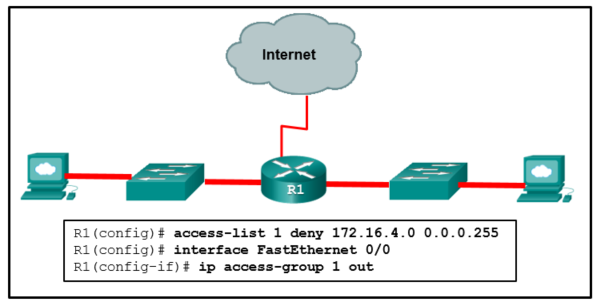
Explanation: Because of the implicit deny at the end of all ACLs, the access-list 1 permit any command must be included to ensure that only traffic from the 172.16.4.0/24 subnet is blocked and that all other traffic is allowed.
21. Refer to the exhibit. A network administrator needs to add an ACE to the TRAFFIC-CONTROL ACL that will deny IP traffic from the subnet 172.23.16.0/20. Which ACE will meet this requirement?
Explanation: The only filtering criteria specified for a standard access list is the source IPv4 address. The wild card mask is written to identify what parts of the address to match, with a 0 bit, and what parts of the address should be ignored, which a 1 bit. The router will parse the ACE entries from lowest sequence number to highest. If an ACE must be added to an existing access list, the sequence number should be specified so that the ACE is in the correct place during the ACL evaluation process.
22. Refer to the exhibit. A network administrator configures an ACL on the router. Which statement describes the result of the configuration?

Explanation: In an extended ACL, the first address is the source IP address and the second one is the destination IP address. TCP port number 22 is a well-known port number reserved for SSH connections. Telnet connections use TCP port number 23.
23. Refer to the exhibit. What can be determined from this output?

Explanation: ACL entry 10 in MyACL matches any Telnet packets between host 10.35.80.22 and 10.23.77.101. No matches have occurred on this ACE as evidenced by the lack of a “(xxx matches)” ACE. The deny ip any any ACE is not required because there is an implicit deny ACE added to every access control list. When no matches exist for an ACL, it only means that no traffic has matched the conditions that exist for that particular line. The ACL is monitoring traffic that matches three specific hosts going to very specific destination devices. All other traffic is not permitted by the implicit deny ip any any ACE.
24. Refer to the exhibit. A network administrator wants to permit only host 192.168.1.1 /24 to be able to access the server 192.168.2.1 /24. Which three commands will achieve this using best ACL placement practices? (Choose three.)
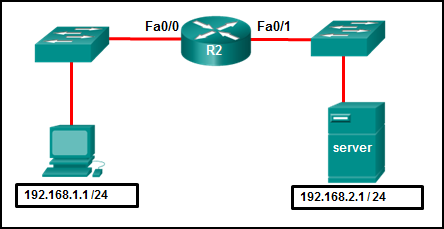
Explanation: An extended ACL is placed as close to the source of the traffic as possible. In this case.it is placed in an inbound direction on interface fa0/0 on R2 for traffic entering the router from host with the IP address192.168.1.1 bound for the server with the IP address192.168.2.1.
25. Consider the following access list.
access-list 100 permit ip host 192.168.10.1 any
access-list 100 deny icmp 192.168.10.0 0.0.0.255 any echo
access-list 100 permit ip any any
Which two actions are taken if the access list is placed inbound on a router Gigabit Ethernet port that has the IP address 192.168.10.254 assigned? (Choose two.)
Explanation: The first ACE allows the 192.168.10.1 device to do any TCP/IP-based transactions with any other destination. The second ACE stops devices on the 192.168.10.0/24 network from issuing any pings to any other location. Everything else is permitted by the third ACE. Therefore, a Telnet/SSH session or ping reply is allowed from a device on the 192.168.10.0/24 network.
26. Refer to the exhibit. The named ACL “Managers” already exists on the router. What will happen when the network administrator issues the commands that are shown in the exhibit?

27. In which TCP attack is the cybercriminal attempting to overwhelm a target host with half-open TCP connections?
Explanation: In a TCP SYN flood attack, the attacker sends to the target host a continuous flood of TCP SYN session requests with a spoofed source IP address. The target host responds with a TCP-SYN-ACK to each of the SYN session requests and waits for a TCP ACK that will never arrive. Eventually the target is overwhelmed with half-open TCP connections.
28. Which protocol is attacked when a cybercriminal provides an invalid gateway in order to create a man-in-the-middle attack?
Explanation: A cybercriminal could set up a rogue DHCP server that provides one or more of the following:
29. Refer to the exhibit. An administrator has configured a standard ACL on R1 and applied it to interface serial 0/0/0 in the outbound direction. What happens to traffic leaving interface serial 0/0/0 that does not match the configured ACL statements?
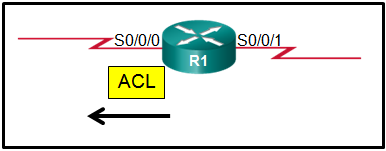
Explanation: Any traffic that does not match one of the statements in an ACL has the implicit deny applied to it, which means the traffic is dropped.
30. Refer to the exhibit. The Gigabit interfaces on both routers have been configured with subinterface numbers that match the VLAN numbers connected to them. PCs on VLAN 10 should be able to print to the P1 printer on VLAN 12. PCs on VLAN 20 should print to the printers on VLAN 22. What interface and in what direction should you place a standard ACL that allows printing to P1 from data VLAN 10, but stops the PCs on VLAN 20 from using the P1 printer? (Choose two.)
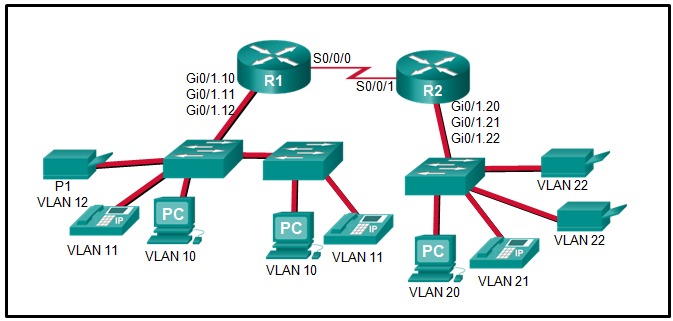
Explanation: A standard access list is commonly placed as close to the destination network as possible because access control expressions in a standard ACL do not include information about the destination network.
The destination in this example is printer VLAN 12 which has router R1 Gigabit subinterface 0/1/.12 as its gateway. A sample standard ACL that only allows printing from data VLAN 10 (192.168.10.0/24), for example, and no other VLAN would be as follows:
R1(config)# access-list 1 permit 192.168.10.0 0.0.0.255 R1(config)# access-list 1 deny any R1(config)# interface gigabitethernet 0/1.12 R1(config-if)# ip access-group 1 out
31. Which statement describes a characteristic of standard IPv4 ACLs?
Explanation: A standard IPv4 ACL can filter traffic based on source IP addresses only. Unlike an extended ACL, it cannot filter traffic based on Layer 4 ports. However, both standard and extended ACLs can be identified with either a number or a name, and both are configured in global configuration mode.
32. What is considered a best practice when configuring ACLs on vty lines?
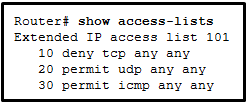
33.
Refer to the exhibit. An administrator first configured an extended ACL as shown by the output of the show access-lists command. The administrator then edited this access-list by issuing the commands below.
Router(config)# ip access-list extended 101 Router(config-ext-nacl)# no 20 Router(config-ext-nacl)# 5 permit tcp any any eq 22 Router(config-ext-nacl)# 20 deny udp any any
Which two conclusions can be drawn from this new configuration? (Choose two.)
Explanation: After the editing, the final configuration is as follows:
Router# show access-lists
Extended IP access list 101
5 permit tcp any any eq ssh
10 deny tcp any any
20 deny udp any any
30 permit icmp any any
So, only SSH packets and ICMP packets will be permitted.
34. Which set of access control entries would allow all users on the 192.168.10.0/24 network to access a web server that is located at 172.17.80.1, but would not allow them to use Telnet?
Explanation: For an extended ACL to meet these requirements the following need to be included in the access control entries:
35. What is the term used to describe a mechanism that takes advantage of a vulnerability?
36. Refer to the exhibit. The network administrator has an IP address of 192.168.11.10 and needs access to manage R1. What is the best ACL type and placement to use in this situation?

Explanation: Standard ACLs permit or deny packets based only on the source IPv4 address. Because all traffic types are permitted or denied, standard ACLs should be located as close to the destination as possible.
Extended ACLs permit or deny packets based on the source IPv4 address and destination IPv4 address, protocol type, source and destination TCP or UDP ports and more. Because the filtering of extended ACLs is so specific, extended ACLs should be located as close as possible to the source of the traffic to be filtered. Undesirable traffic is denied close to the source network without crossing the network infrastructure.
37. A technician is tasked with using ACLs to secure a router. When would the technician use the any configuration option or command?
38. Which statement accurately characterizes the evolution of threats to network security?
Explanation: Internal threats can be intentional or accidental and cause greater damage than external threats because the internal user has direct access to the internal corporate network and corporate data.
39. A user receives a phone call from a person who claims to represent IT services and then asks that user for confirmation of username and password for auditing purposes. Which security threat does this phone call represent?
Explanation: Social engineering attempts to gain the confidence of an employee and convince that person to divulge confidential and sensitive information, such as usernames and passwords. DDoS attacks, spam, and keylogging are all examples of software based security threats, not social engineering.
40. In what way are zombies used in security attacks?
Explanation: Zombies are infected computers that make up a botnet. The zombies are used to deploy a distributed denial of service (DDoS) attack.
41. Which attack involves threat actors positioning themselves between a source and destination with the intent of transparently monitoring, capturing, and controlling the communication?
Explanation: The man-in-the-middle attack is a common IP-related attack where threat actors position themselves between a source and destination to transparently monitor, capture, and control the communication.
42. Which two keywords can be used in an access control list to replace a wildcard mask or address and wildcard mask pair? (Choose two.)
Explanation: The host keyword is used when using a specific device IP address in an ACL. For example, the deny host 192.168.5.5 command is the same is the deny 192.168.5.5 0.0.0.0 command. The any keyword is used to allow any mask through that meets the criteria. For example, the permit any command is the same as permit 0.0.0.0 255.255.255.255 command.
43. Which statement describes a difference between the operation of inbound and outbound ACLs?
Explanation: With an inbound ACL, incoming packets are processed before they are routed. With an outbound ACL, packets are first routed to the outbound interface, then they are processed. Thus processing inbound is more efficient from the router perspective. The structure, filtering methods, and limitations (on an interface, only one inbound and one outbound ACL can be configured) are the same for both types of ACLs.
44. What effect would the Router1(config-ext-nacl)# permit tcp 172.16.4.0 0.0.0.255 any eq www command have when implemented inbound on the f0/0 interface?
45. Which ACE will permit a packet that originates from any network and is destined for a web server at 192.168.1.1?
46. Refer to the exhibit. A new network policy requires an ACL denying FTP and Telnet access to a Corp file server from all interns. The address of the file server is 172.16.1.15 and all interns are assigned addresses in the 172.18.200.0/24 network. After implementing the ACL, no one in the Corp network can access any of the servers. What is the problem?
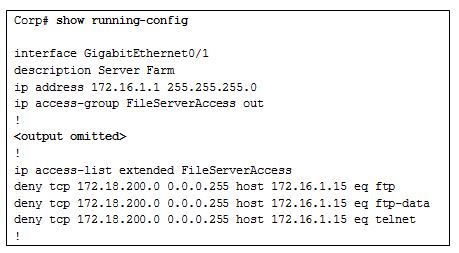
CCNA 3 v7 Modules 3 – 5: Network Security Exam Answers 46
Explanation: Both named and numbered ACLs have an implicit deny ACE at the end of the list. This implicit deny blocks all traffic.
47. A technician is tasked with using ACLs to secure a router. When would the technician use the access-class 20 in configuration option or command?
48. What is the term used to describe the same pre-shared key or secret key, known by both the sender and receiver to encrypt and decrypt data?
49. Refer to the exhibit. Internet privileges for an employee have been revoked because of abuse but the employee still needs access to company resources. What is the best ACL type and placement to use in this situation?
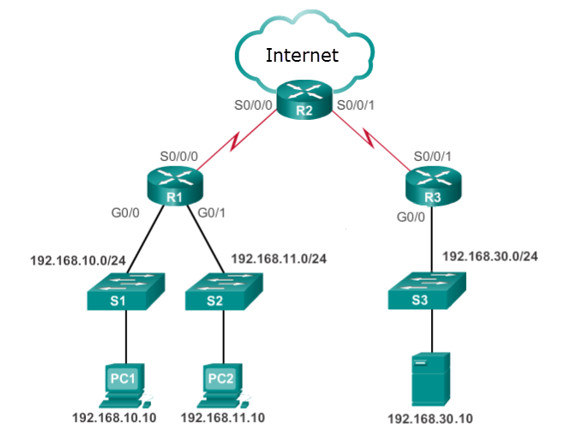
CCNA 3 v7 Modules 3 – 5: Network Security Exam Answers 49
Explanation: – Standard ACLs permit or deny packets based only on the source IPv4 address. Because all traffic types are permitted or denied, standard ACLs should be located as close to the destination as possible.
– Extended ACLs permit or deny packets based on the source IPv4 address and destination IPv4 address, protocol type, source and destination TCP or UDP ports and more. Because the filtering of extended ACLs is so specific, extended ACLs should be located as close as possible to the source of the traffic to be filtered. Undesirable traffic is denied close to the source network without crossing the network infrastructure.
50. Refer to the exhibit. The student on the H1 computer continues to launch an extended ping with expanded packets at the student on the H2 computer. The school network administrator wants to stop this behavior, but still allow both students access to web-based computer assignments. What would be the best plan for the network administrator?

CCNA 3 v7 Modules 3 – 5: Network Security Exam Answers 42
Explanation: This access list must be an extended ACL in order to filter on specific source and destination host addresses. Commonly, the best place for an extended ACL is closest to the source, which is H1. Traffic from H1 travels into the switch, then out of the switch into the R1 Gi0/0 interface. This Gi0/0 interface would be the best location for this type of extended ACL. The ACL would be applied on the inbound interface since the packets from H1 would be coming into the R1 router.
51. A technician is tasked with using ACLs to secure a router. When would the technician use the ‘ip access-group 101 in’ configuration option or command?
52. In which type of attack is falsified information used to redirect users to malicious Internet sites?
Explanation: In a DNS cache poisoning attack, falsified information is used to redirect users from legitimate to malicious internet sites.
53. What is a feature of an IPS?
Explanation: An advantage of an intrusion prevention systems (IPS) is that it can identify and stop malicious packets. However, because an IPS is deployed inline, it can add latency to the network.
54. What is the term used to describe a potential danger to a company’s assets, data, or network functionality?
Explanation: A threat is a potential danger to a company’s assets, data, or network functionality. An exploit is a mechanism that takes advantage of a vulnerability. A vulnerability is a weakness in a system, or its design, that could be exploited by a threat.
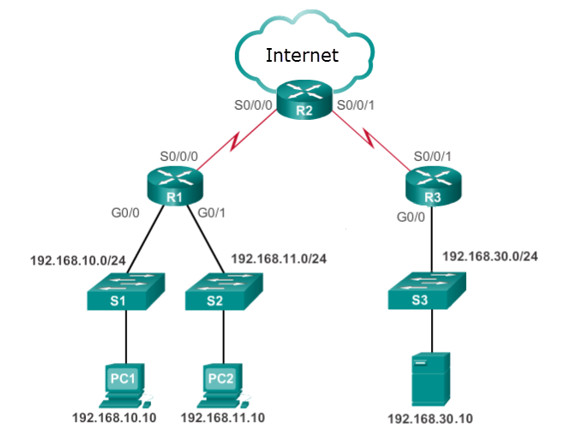
55. Refer to the exhibit. Network 192.168.30.0/24 contains all of the company servers. Policy dictates that traffic from the servers to both networks 192.168.10.0 and 192.168.11.0 be limited to replies for original requests. What is the best ACL type and placement to use in this situation?
Explanation: Standard ACLs permit or deny packets based only on the source IPv4 address. Because all traffic types are permitted or denied, standard ACLs should be located as close to the destination as possible.
Extended ACLs permit or deny packets based on the source IPv4 address and destination IPv4 address, protocol type, source and destination TCP or UDP ports and more. Because the filtering of extended ACLs is so specific, extended ACLs should be located as close as possible to the source of the traffic to be filtered. Undesirable traffic is denied close to the source network without crossing the network infrastructure.
56. What does the CLI prompt change to after entering the command ip access-list standard aaa from global configuration mode?
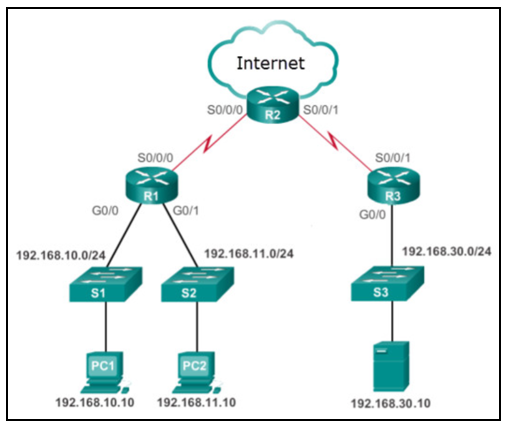
57. Refer to the exhibit. Many employees are wasting company time accessing social media on their work computers. The company wants to stop this access. What is the best ACL type and placement to use in this situation?
58. A technician is tasked with using ACLs to secure a router. When would the technician use the 40 deny host 192.168.23.8 configuration option or command?
59. What is the best description of Trojan horse malware?
60. What wild card mask will match networks 172.16.0.0 through 172.19.0.0?
Explanation: The subnets 172.16.0.0 through 172.19.0.0 all share the same 14 high level bits. A wildcard mask in binary that matches 14 high order bits is 00000000.00000011.11111111.11111111. In dotted decimal this wild card mask is 0.3.255.255.
61. What is the term used to describe gray hat hackers who publicly protest organizations or governments by posting articles, videos, leaking sensitive information, and performing network attacks?
62. A technician is tasked with using ACLs to secure a router. When would the technician use the no ip access-list 101 configuration option or command?
63. What is the term used to describe unethical criminals who compromise computer and network security for personal gain, or for malicious reasons?
Explanation: Black hat hackers are unethical threat actors who use their skills to compromise computer and network security vulnerabilities. The goal is usually financial gain or personal gain, or the hacker may have malicious intent. A vulnerability broker is a gray hat hacker who attempts to discover exploits and report them to vendors, sometimes for prizes or rewards. Hacktivists are gray hat hackers who publicly protest organizations or governments by posting articles or videos, leaking sensitive information, and performing network attacks. Script kiddies are inexperienced hackers (sometimes teenagers) running existing scripts, tools, and exploits to cause harm—but typically not for profit.
64. What is the term used to describe a guarantee that the message is not a forgery and does actually come from whom it states?
65. A technician is tasked with using ACLs to secure a router. When would the technician use the ip access-group 101 in configuration option or command?
66. A technician is tasked with using ACLs to secure a router. When would the technician use the remark configuration option or command?
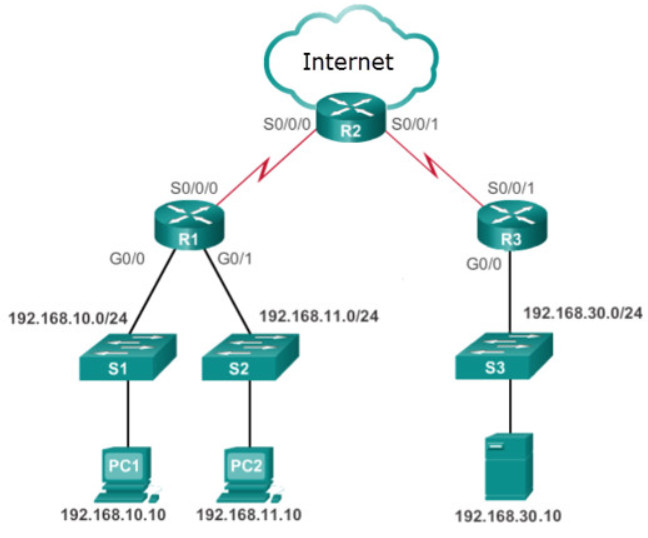
67. Refer to the exhibit. The company CEO demands that one ACL be created to permit email traffic to the internet and deny FTP access. What is the best ACL type and placement to use in this situation?
68. A technician is tasked with using ACLs to secure a router. When would the technician use the established configuration option or command?
69. A technician is tasked with using ACLs to secure a router. When would the technician use the deny configuration option or command?

70. Refer to the exhibit. Only authorized remote users are allowed remote access to the company server 192.168.30.10. What is the best ACL type and placement to use in this situation?
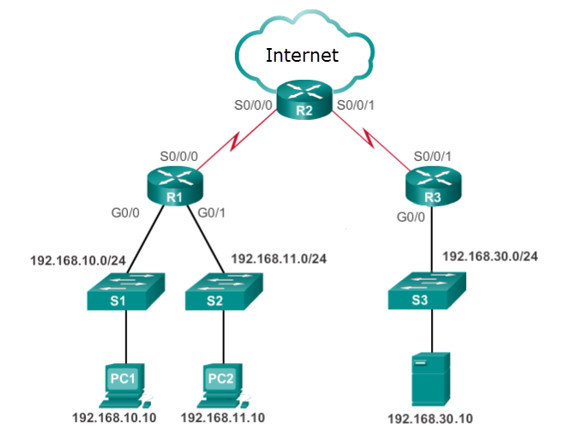
71. Refer to the exhibit. Employees on 192.168.11.0/24 work on critically sensitive information and are not allowed access off their network. What is the best ACL type and placement to use in this situation?
72. A technician is tasked with using ACLs to secure a router. When would the technician use the host configuration option or command?
73. What commonly motivates cybercriminals to attack networks as compared to hacktivists or state-sponsored hackers?
Explanation: Cybercriminals are commonly motivated by money. Hackers are known to hack for status. Cyberterrorists are motivated to commit cybercrimes for religious or political reasons.
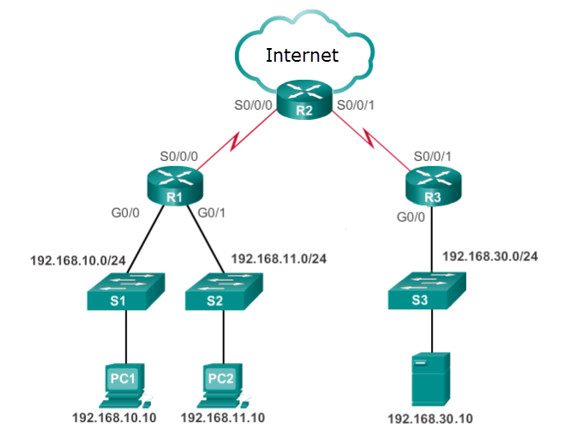
74. Refer to the exhibit. The company has provided IP phones to employees on the 192.168.10.0/24 network and the voice traffic will need priority over data traffic. What is the best ACL type and placement to use in this situation?
Explanation: Standard ACLs permit or deny packets based only on the source IPv4 address. Because all traffic types are permitted or denied, standard ACLs should be located as close to the destination as possible.
Extended ACLs permit or deny packets based on the source IPv4 address and destination IPv4 address, protocol type, source and destination TCP or UDP ports and more. Because the filtering of extended ACLs is so specific, extended ACLs should be located as close as possible to the source of the traffic to be filtered. Undesirable traffic is denied close to the source network without crossing the network infrastructure.